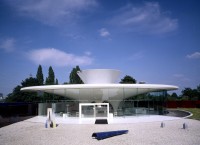Der nackte Putto hat den Schafsbock am Kopf und Hinterteil gepackt. Da das Tier zu bocken scheint, reißt der Putto vor Empörung seinen Mund auf.
An der Rückseite ist der Sockel mit einer eingetieften Signatur (Inschrift) mit Firmenbezeichnung, ein Bild mit einer Bartmaske und die Ortsangabe versehen.
Die Inschrift "F A" verweist auf Franz Albermann, nach dessen Entwurf die Arbeit im Jahre 1926 erstand.
Weiter weist die Signatur den Herstllungsort auf: KALSCHEUERWERK / FRECHEN.
Die Figur befand sich auf einem Pfeiler am Eingang zum Hof der Marienschule und gelangte beim Abriss der Pfeiler nach dem Zweiten Weltkrieg ins Museum.
en

